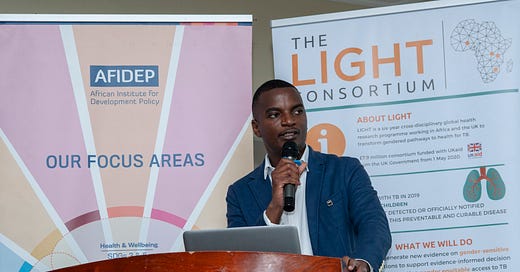Malawi’s weak investment in Tuberculosis derails lung health
To tackle TB, the country needs to invest in domestic resource mobilization reduce over-reliance on donors and ensure a gender approach towards TB.
Opinion
Lilongwe, Malawi-The advent of COVID-19 brought a lot of challenges to the country’s health sector, leading to the derailment of the health budget, human resources for health, and a general weakening of the economy,, leading to a decline in the quality of health services. but new evidence shows that Malawi is far from winning the fight against tuberculosis, one of the oldest infectious diseases in our lifetime, writes Dingaan Mithi.
At a media science café organized by the Journalists Association Against AIDS (JournAIDS) in collaboration with the African Institute for Development Policy (AFIDEP), a think tank based in Malawi and Kenya, Dr. Benjamin Azariah Mosiwa, AFIDEP’s research and policy associate made it clear that weak financing towards TB is frustrating efforts to tackle the infectious disease.
In a political economy analysis on TB in Malawi titled “Leaving no-one behind Transforming gendered pathways to health for TB,” Mosiwa says that increased reliance on foreign borrowing and donor aid is making efforts to tackle TB to falter, with a decline in overseas development aid, while widespread poverty is also compounding TB.
Malawi remains predominantly an agricultural economy where agriculture accounts for 35% of the GDP and more than 80% of export earnings (primarily from tobacco sales) and it supports more than 80% of the population. Development aid has been key in stabilizing the economy over the past 30 years. In addition, diaspora remittances increasingly contribute to the country’s economy.
Tuberculosis is one of the infectious diseases that is linked to poverty, while poor nutrition also makes treatment and adherence to TB drugs problematic, This has also been singled out as a factor of TB treatment failure, while people can stop taking drugs to the high pill burden and lack of food for better adherence.
“Poverty in Malawi is one of the factors contributing to the weak fight against TB, also this country has been over-reliant on donors for a long time. These factors frustrate the TB response in the country” stressed Mosiwa
On a positive note, the 2021-2025 National Strategic Plan for the National TB and Leprosy Elimination Program (NTLEP), shows a declining trend in the rate of new and relapse notifications per 100,000 population from 129 in 2012 to 88 in 2018. Cases slightly increased in 2017 (94 per 100,000 population), which is attributed to the expansion of TB classifications to include relapse cases. Notification rates for bacteriologically confirmed TB cases fell from 46 per 100,000 population in 2012 to 35 per 100,000 population in 2014, albeit with slight increases in 2015 and 2016 (per 100,000 in both years). This could be attributable to the implementation of GeneXpert.
The rate of clinically diagnosed TB has substantially and consistently decreased in recent years, from 44 per 100,000 population in 2012 to 19 per 100,000 population in 2018, which likely is a result of both the availability of a rapid molecular test, GeneXpert, and the very high coverage of antiretroviral treatment (ART) achieved in Malawi.
The political economy analysis is part of AFIDEP’s work in a TB LIGHT consortium that consists of the London School of Hygiene and Tropical Medicine, Malawi Liverpool Wellcome Trust, Makerere University Lung Institute, Respiratory Society of Kenya, Zankii Research Center, Liverpool School of Tropical Medicine, with funding from UKAID.
The six-year TB LIGHT project notes that despite TB being preventable and curable, it remains a global public health concern, with an estimated 10.6 million people infected with the disease in 2021 alone. It notes that Africa is still considered a high-burden region for TB, estimated to have accounted for 25 percent of all TB cases globally in 2019.
In Malawi, TB incidence was estimated at 133 cases per 100,000 and mortality was reported to be at about 31 deaths per 100,000 population.
“In Malawi, though recent gender disaggregated data was not found, TB is similarly reported to be higher among males, who are estimated to account for 57 percent of all TB cases in the country” reads part of a TB LIGHT project backgrounder
NTLEP fellow, Dr. Samuel Chirwa notes that Malawi should enhance access to TB treatment invest in adequate financing and ensure that men are at the forefront of the TB response. The fact that TB affects more men than women is a wake-up call to enhance a gendered transformative approach to tackling TB.
“The high of TB among men has been attributed to several behavioural, biological and socioeconomic risk factors more prevalent among men, such as smoking tobacco, alcohol consumption, mining, frequent travelling and social mixing” adds the TB LIGHT backgrounder
Malawi also grapples with drug-resistant TB, the NTLEP shows that the country conducted its first Drug Resistance Survey (DRS) in 2013. With a prevalence of 4.8% among retreatment and 0.48% among new patients, the country is expected to notify a total of approximately 200 patients annually. The DRS together with the rollout of GeneXpert platforms explain the jump in notification for that year and the subsequent years. It is worth noting that since 2014, patients with Rifampicin resistance (RR) after a second confirmation test are treated using second-line treatment. This has contributed to a sharp increase in the number of patients on Second Line Drugs (SLD) since 2014.
To tackle TB, the country needs to invest in domestic resource mobilization reduce over-reliance on donors and ensure a gender approach towards TB. All is not lost, there is some good news that shows Malawi is achieving ending TB milestones for incidence and mortality related to TB with a 59 percent in reduction in mortality and 37% reduction in TB incidence compared to the 2015 baseline.



